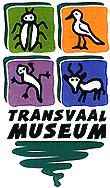

New AdditionsRecent additions to the Transvaal Museum building include two new wings while the biodomes are almost finished. The new south wing will house a huge display hall, as well as the herpetology and lower invertebrate departments. The new hall will be used for topical displays. The new north wing will house the lepidoptera department and new education facilities including an auditorium with lecture and film facilities as well as classrooms. Another welcome addition is the à la carte restaurant and fast-food kiosk.
The south biodome will house a highveld ecosystem, while visitors to the north biodome can have a closer look at a lowveld ecosystem. These
biodomes are not gardens, but carefully designed self-sustaining systems,
with guilds of plants and small animals living in the sites. Visitors
will be able to walk through them, and go up the ramps to experience
the system at all heights. Imagine being able to look into the crown
of a fever tree and meet a lizard eye to eye! south biodome will house a highveld ecosystem, while visitors to the north biodome can have a closer look at a lowveld ecosystem. These
biodomes are not gardens, but carefully designed self-sustaining systems,
with guilds of plants and small animals living in the sites. Visitors
will be able to walk through them, and go up the ramps to experience
the system at all heights. Imagine being able to look into the crown
of a fever tree and meet a lizard eye to eye!
Display Halls
The Genesis of Life I
The concept of narrative display is used to trace the origins and diversity of life on earth, from the simplest single-celled organisms, through the various stages of biological complexity.
The Genesis of Life II
The prehistory and way of life of early man is explained. Other exhibits include reconstructions of prehistoric mammal-like reptiles of the Karoo, as well as displays on whales, primates and hoofed mammals.
The Austin Roberts Bird Hall
The diversity of birdlife is displayed. Bird specimens are numerically arranged according to the authoritative work Roberts' Birds of Southern Africa. The displays convey general information about birds, their feeding, reproduction and flight.
The Museum of the Geological Survey
This museum is situated in the Transvaal Museum building and resorts under the Geological Survey. It houses a comprehensive collection of minerals, precious and semiprecious stones.
|


 south biodome will house a highveld ecosystem, while visitors to the north biodome can have a closer look at a lowveld ecosystem. These
biodomes are not gardens, but carefully designed self-sustaining systems,
with guilds of plants and small animals living in the sites. Visitors
will be able to walk through them, and go up the ramps to experience
the system at all heights. Imagine being able to look into the crown
of a fever tree and meet a lizard eye to eye!
south biodome will house a highveld ecosystem, while visitors to the north biodome can have a closer look at a lowveld ecosystem. These
biodomes are not gardens, but carefully designed self-sustaining systems,
with guilds of plants and small animals living in the sites. Visitors
will be able to walk through them, and go up the ramps to experience
the system at all heights. Imagine being able to look into the crown
of a fever tree and meet a lizard eye to eye!